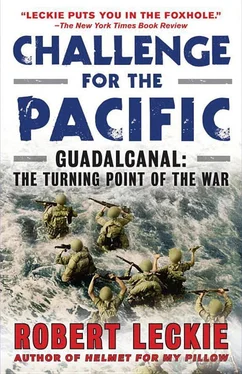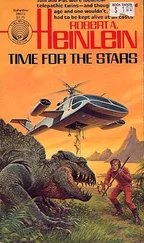Martin Clemens looked at the teleradio MacFarlan had brought him. This and his police scouts would be about all he had, not to “deny the enemy,” but to spy on the enemy—once they came.
For Martin Clemens, besides being a British District Officer, was also a coastwatcher for the Royal Australian Navy.
Lieutenant Commander Eric Feldt of the Royal Australian Navy directed the coastwatchers, that unique organization of brave and resourceful men who operated inside Japanese-occupied territory to report on enemy movements. It was Commander Feldt who had sent MacFarlan south to instruct Clemens and the others in the use of the teleradio and to teach them code. They were not of much use at the moment, but they would be, for the enemy operation obviously preparing in Rabaul would most certainly engulf the Southern Solomons.
Coastwatchers of the Northern Solomons, and on the tiny islands off-lying Rabaul and her sister base of Kavieng on New Ireland, were already operating. It was they who had reported the Japanese invasion build-up, and their signals describing enemy aerial formations had been invaluable in alerting bases such as Port Moresby to the danger of air raids.
In choosing his coastwatchers, Feldt had generally selected “islanders”—mostly Australians—who scorned to wear any man’s collar and had found the independence they prized in the untamed islands of Melanesia. They were planters, ship captains, goldminers, or unmitigated scamps, with here and there a black-birder or slave-trader. They drank very, very hard, loved widely and freely, looked down upon the natives with a protective paternalism—and spoke a language which, bristling with “bleddy” this and “baaastid” that, was unprintable in the extreme, especially when it relied upon a famous four-letter word which was used to modify everything except the sexual act that it described. Missionaries were always shocked to discover that the pidgin English they were expected to use was studded with these words. Ashes, for example, were described as “shit-belong-fire” and an enemy bombing raid reported as, “Japan he shit along sky.”
However their shortcomings, the islanders were intensely loyal. They could be relied upon to hate the Japanese with the fine and fruitful ferocity of the free man who has his back to the wall. Because of this, they were chosen by Feldt; and it was a wise choice.
By the end of March a coastwatching chain extending from New Ireland down to San Cristoval at the southern end of the Solomons was complete. The men in the perilous northern stations, absolutely dependent upon the fidelity of their native scouts—none of whom would ever betray them—skillfully eluded Japanese patrols while continuing to feed precious information into the Allied Intelligence network functioning in Australia under the command of General MacArthur.
A few days before General Douglas MacArthur made his dramatic escape by torpedo boat from Corregidor, the big carrier Enterprise dropped anchor in Pearl Harbor after a successful bombing raid on Japanese-held Marcus Island. On her bridge was a pugnacious admiral with a huge commanding head and a craggy bristling face. He was William F. (Bull) Halsey, perhaps the most aggressive admiral in the American Navy. Bull Halsey had already led the strikes on Wake and the Marshalls, and was already famous at home for his hatred of the enemy and his salty contempt for fainthearted sailors. The day Admiral Halsey had sailed into Pearl Harbor and seen the horrible wreckage of the fleet in Battleship Row, he had snarled through clenched teeth: “Before we’re through with ’em the Japanese language will be spoken only in hell!” A few days later, at sea again and infuriated by a bad case of jitters developing in his task force, he signaled his ships: WE ARE WASTING TOO MANY DEPTH CHARGES ON NEUTRAL FISH.
Halsey and the Enterprise were not to remain long in Pearl, for Admiral Chester Nimitz, Commander of the Pacific Ocean Area, had an assignment for him. The white-haired Nimitz explained it briskly to his most valued commander: in January of 1942, Admiral King had conceived the idea of staging a spectacular diversionary raid on Japan. King’s proposal had received the enthusiastic support of General Arnold of the Army Air Force. Arnold had agreed to provide sixteen long-range Mitchell medium bombers under command of Lieutenant Colonel James Doolittle. They were to be trained to take off from Navy carriers. That force was now ready.
Nimitz asked Halsey, “Do you believe it would work, Bill?”
“They’ll need a lot of luck.”
“Are you willing to take them out there?”
“Yes, I am.”
“Good!” Nimitz said. “It’s all yours!” 8
Bull Halsey left Nimitz’s headquarters to confer with Doolittle. They agreed that they would try to sneak to within 400 miles of Japan, but that they would launch the planes from farther out if they were discovered. They agreed also, gleefully, that the attack would rattle the enemy’s front teeth, even though it was far from making a real war of it with Japan.
War with Japan, the United States Marine Corps had maintained for three decades, would be a naval war, an island war, an amphibious war. In 1921, one of the Marines’ most thoughtful officers, Lieutenant Colonel Earl (“Pete”) Ellis, wrote a prescient essay which began with the words:
“Japan is a World Power and her army and navy will doubtless be up to date as to training and matériel. Considering our consistent policy of non-aggression, she will probably initiate the war; which will indicate that, in her own mind, she believes that, considering her natural defensive position, she has sufficient military strength to defeat our fleet.”
From this, Ellis concluded:
“In order to impose our will upon Japan, it will be necessary for us to project our fleet and land forces across the Pacific and wage war in Japanese waters. To effect this requires that we have sufficient bases to support the fleet, both during its projection and afterwards.” 9
Bases meant islands, Ellis argued, and many of these would be defended. No matter, they would have to be seized; and Ellis went on to forecast, with remarkable accuracy, the kind and size of force that would be needed to do it. Unfortunately, Ellis lost his life while on an espionage mission in the Pacific, murdered, some investigators suggest, by the Japanese within their Caroline Islands bastion. 10But Ellis’s conclusions were not forgotten by the officers who were to command the Marine Corps in the years between the wars.
Chief of all, these men refused to accept the dreary dictum which the British debacle at Gallipoli in World War I seemed to have laid down: that hostile and defended shores cannot be seized from the sea. The Marines argued that they could; moreover that it was not necessary to capture ports with all their ship facilities but that invasions could be made across open beaches. Most brass ears were deaf to this doctrine. Many generals, and some admirals, regarded Marines as nothing but beach-jumpers 11who were unfit to command more than a platoon, 12let alone evolve and develop new military doctrine. After all, the Marine Corps was a mere auxiliary force of scarcely twenty thousand men; it was only, in the favorite phrase of its detractors—one which President Harry Truman was to make notoriously erroneous in the Korean War—“the Navy’s police force.”
But the Marines persevered. They had to. Without amphibious warfare they had no reason to be regarded as anything else but naval police. Fighting for their existence, they developed amphibious tactics and equipment. The New Orleans boatbuilder, Andrew Higgins, was encouraged to continue experimenting—sometimes at his own expense—with better and better types of landing craft; and from the inventor Donald Roebling came the Alligator, a tracked boat able to crawl over land obstacles, which was to be the forerunner of the famous “amtrack.” Practice landings were made whenever the Navy could be persuaded to make a few ships available. And anything that was done had to be done on a shoestring, for American Congresses between world wars were as bellicosely pacifist as the Cold War Congresses have been meekly militarist. Military budgets were gleefully meat-axed to the starry-eyed approval of a nation naively convinced that if you turn your back on war it will go away. Foremost in this American between-wars custom of “making mock of uniforms that guard you while you sleep” was the Senate Armed Forces Committee that sought to embarrass the Army Chief of Staff, General Douglas MacArthur, by inquiring if the Army really needed all of that toilet paper it had ordered. In such surroundings, caught between two fires, as it were, the Marines worked out their ideas on amphibious warfare.
Читать дальше












